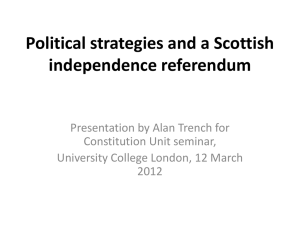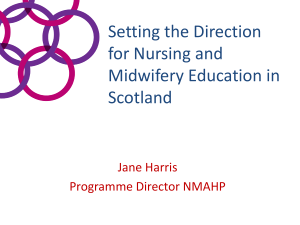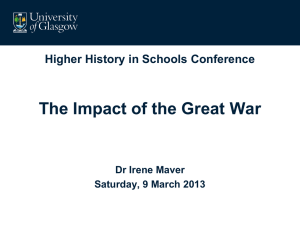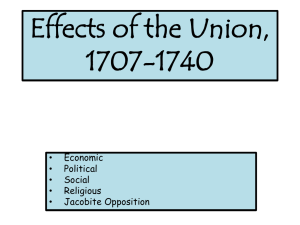The funding of higher education in Scotland
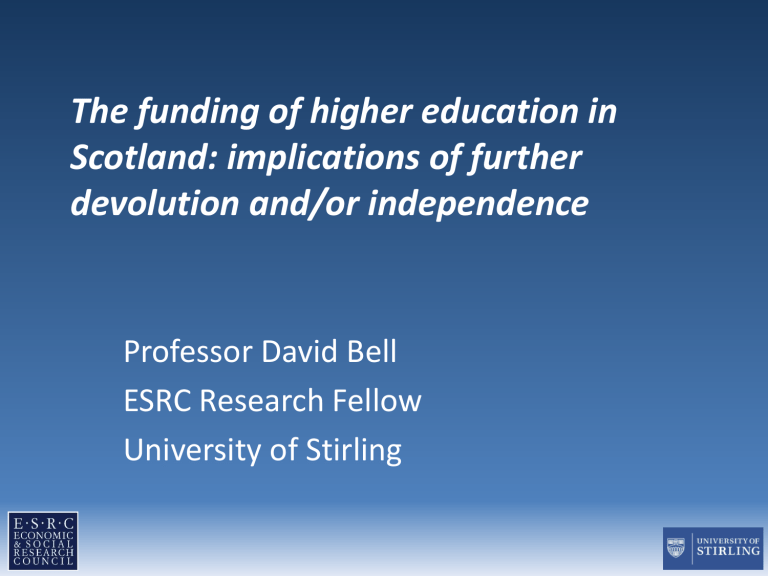
The funding of higher education in
Scotland: implications of further devolution and/or independence
Professor David Bell
ESRC Research Fellow
University of Stirling
1
INTRODUCTION
2
Constitutional Options for Scotland
• Status Quo
• Devo +
• Devo More
• Full Fiscal Autonomy
• Independence
3
The Status Quo - Scottish Budget 2013-14
SG Spending Limits — Cash Terms
Revenue DEL
Capital DEL
Total
Real-Terms Change – year on year
Real-Terms Change – cumulative
2010-11
£m
2011-12
£m
2012-13
£m
2013-14
£m
2014-15
£m
27,259 26,270 25,896 25,429 24,961
3,462 2,837 2,707 2,319 2,320
30,721 29,107 28,603 27,748 27,281
-5.3% -1.7% -3.0% -1.7%
-5.3% -6.9% -9.7% -11.2%
Scottish Further and Higher Education Funding
Council
Scottish Funding Council FE Programme
Scottish Funding Council HE Programme
Scottish Funding Council FE/HE Capital
Scottish Funding Council Administration
Total Level 2 of which:
DEL Resource
DEL Capital
2012-13
Budget
£m
2013-14
Draft
Budget
£m
2014-15
Plans
£m
506.9
1,002.2 1,041.6
60.7
7.9
511.7
45.9
7.9
4
470.7
1,061.8
56.4
7.9
1,577.7 1,607.1
1,596.8
1,517.0 1,561.2
1,540.4
60.7
45.9
56.4
The Status Quo - Scottish Budget 2013-14
Higher Education Student Support
Level 3
DEL
Student Support and Tuition Fee Payments
Student Loan Company Administration Costs
Student Loan Interest Subsidy to Bank
Cost of Providing Student Loans (RAB Charge) (Non-
Cash)
Student Awards Agency for Scotland Operating Costs
AME
Net Student Loans Advanced
Capitalised Interest
Student Loans Fair Value Adjustment
Student Loan Sale Subsidy Impairment Adjustments
Total Level 2 of which:
DEL Resource
DEL Capital
AME
2012-13
Budget
£m
2013-14
Draft
Budget
£m
2014-15
Plans
£m
325.9
302.4
5.0
5.0
4.5
4.5
88.4
134.0
8.4
8.7
307.0
5.0
4.5
181.6
8.7
241.3
408.3
(47.0) (50.0)
(69.0) (69.0)
0.5
0.5
558.0
744.4
431.8
454.2
0.4
0.4
125.8
289.8
468.3
(52.0)
(69.0)
0.5
854.6
506.4
0.4
347.8
5
Alternatives to independence
• Devo plus and devo more
– No obvious implications for HE sector relative to status quo.
• Fiscal autonomy – research councils part of “shared services”?
“A payment from Edinburgh to London would be required to cover common UK public goods and services (i.e. “shared services”). The range of services included in this basket of “shared services”, how they would be paid for, and the authority the Scottish Parliament would have over such policies, would be subject to negotiation at the time of any revised settlement” (Fiscal Autonomy in Scotland, Scottish Government 2009)
Would the research councils form part of these shared services?
6
Independence and Higher Education
• Key questions for Scottish Government
– Would an independent Scotland want to increase/decrease level of support for HE
– Could it afford increased support?
• Existing structures and relationships
– Student demography – stocks and flows
– University funding
• The tuition fee issue
– A proposed solution
7
DESIRABILITY AND AFFORDABILITY OF
POST-INDEPENDENCE HE SUPPORT
8
Graduates make up an increasing share of the Scottish workforce
2,50
2,00
1,50
1,00
Graduate
Non-graduate
0,50
0,00
9
Graduate premium declining slightly
100%
90%
80%
70%
60%
50%
40% rUK
Scotland
Graduate premium = Graduate wage/non-graduate wage – 1
Source: Labour Force Survey
10
Spending on HE in UK low, but effective
3,0
2,5
2,0
1,5
1,0
0,5
0,0
Iceland United
Kingdom
Norway Ireland Sweden Denmark Finland Korea United
States
29 of the world top 200 universities in the UK
11
Scottish HE Institutions 2012 – Significant Income
Generation
£1 000m
£900m
£800m
£700m
£600m
£500m
£400m
£300m
£200m
£100m
£0m
Funding
Council grants
Tuition fees Research grants and contracts
Other income Endowment and investment income
12
Scottish Growth Sectors Have Strong Links to HE
• Oil and Gas
• Food and Drink
• Technology and Engineering
• Renewable Energy
• Life Sciences
• Tourism
• Creative Industries
• Financial and Business Services
• Chemical Sciences
• Construction
• Forest and Timber Technologies
• Textiles
Unlikely to change immediately post-independence
13
HE as an export earner in an independent Scotland?
• Issues
– Migration/visa policy
• Implications for border arrangements?
– Co-operative/competitive outcomes among institutions
– Technological challenges
– Product differentiation
• What makes a Scottish HE course better?
– Policies to attract best scholars
• Salaries, working conditions etc
14
STUDENT DEMOGRAPHICS
15
Potential student numbers in Scotland static, growing in
England
120
110
100
90
80
70
60
Scotland
Wales
NI
England
181716151413121110 9 8 7 6 5 4 3 2 1 0
Current Age
16
Scottish Higher Education Initial Participation Rate (HEIPR) static
60%
50%
40%
30%
20%
10%
0%
2006-07 2007-08 2008-09 2009-10 2010-11
Other HE
HNC/HND
First Degree
17
Share of Students studying in HEIs in the UK by domicile and country of institution: 2009-10
100%
90%
80%
70%
60%
50%
40%
30%
20%
10%
0%
17,9%
12,6%
72,4%
Scotland
17,3%
2,6%
18,2%
25,5%
84,5%
58,0%
England Wales
Country of Institution
11,5%
2,4%
92,1%
Northern Ireland
International students
Other Uk students
Home students
18
RUK students share varies by institution
Proportion of RUK Students in Undergraduate Intake
The University of St Andrews
The University of Edinburgh
Glasgow School of Art
Edinburgh College of Art
The Royal Scottish Academy of Music
Heriot-Watt University
The University of Aberdeen
Queen Margaret University
The University of Glasgow
The University of Stirling
The Univerisity of Dundee
University of Abertay
Edinburgh Napier
Glasgow Caledonian
The University of Strathclyde
The Rober Gordon University
Scottish Agricultural College
UHI Millennium Institute
The University of West of Scotland
Bell College
0% 10% 20% 30% 40%
These data are calculated from HESA microdata and provided by Marta Odendal 19
50% 60%
Significant post-graduation cross-border flows
First Career Destination of Students Entering
University 2003-2006
100%
90%
80%
70%
60%
50%
40%
30%
20%
10%
0%
Scottish Students at Scottish
Institutions
RUK Students at
Scottish
Institutions
Scottish Students at RUK
Institutions
First Career Destination World
First Career Destination EU
First Career Destination RUK
First Career Destination
Scotland
These data are calculated from HESA microdata and provided by Marta Odendal 20
More rUK students come to Scotland
Ratio of student flow rUK-> Scotland to
Scotland -> rUK
8,0
7,0
6,0
5,0
4,0
3,0
2,0
1,0
0,0
2003 2004 2005 2006
These data are calculated from HESA microdata and provided by Marta Odendal 21
FUNDING
22
Spending relative to population on HE is high in Scotland
140%
120%
100%
80%
60%
40%
20%
0%
England Wales Northern
Ireland
Scotland
Public Spending
Higher Education
23
Income by Institution 2011-12
The University of Edinburgh
The University of Glasgow
The University of Strathclyde
The University of Dundee
The University of Aberdeen
The University of St Andrews
Heriot-Watt University
Glasgow Caledonian University
Edinburgh Napier University
The University of Stirling
The University of the West of Scotland
The Robert Gordon University
University of the Highlands and Islands
SRUC
Queen Margaret University, Edinburgh
University of Abertay Dundee
Glasgow School of Art
Royal Conservatoire of Scotland
£m £100m £200m £300m £400m £500m £600m £700m £800m
24
The Funding Status Quo
• No tuition fees charged for higher education in
Scotland
• Fees of up to £9000 per annum payable in rest of
UK. Those charging fees above £6,000 have to allocate some funding to widening access initiatives.
• But according to the NUS, even with tuition fees in
England, “ Scotland has the worst record on widening access in the whole of the UK ”
25
Income from tuition fees and education contracts by country of HE institution 2011/12
Northern Ireland
Scotland
Wales
England
0% 20% 40% 60% 80% 100%
Full-time undergraduate
Full-time postgraduate
Part-time undergraduate
Part-time postgraduate
Non-EU domicile students
26
SFC support varies by institutional size and makeup
£160 000 000
£140 000 000
£120 000 000
£100 000 000
£80 000 000
£60 000 000
£40 000 000
£20 000 000
£0
Research
Postgraduate
Grant
Research
Excellence
Grant
Teaching
Grant
27
Non-Scottish domiciled students in higher education in
Scottish HEIs and colleges by domicile: 2000-01 to 2009-10
35 000
30 000
25 000
20 000
15 000
10 000
5 000
0
2000-
01
2001-
02
2002-
03
2003-
04
20042005-
06
2006-
07
2007-
08
2008-
09
2009-
10
28
Rest of
UK
EU
Non-EU
Increased flows from rUK during “noughties” – fee effect?
% Change in student numbers in Scottish HEIs and colleges from UK countries since 2000-01
25%
20%
15%
10%
22,1%
22,9%
5%
-0,1%
0%
The zero line
-5% change since
2000-01.
-10%
2000-
01
2001-
02
2002-
03
2003-
04
2004-
05
2005-
06
2006-
07
2007-
08
2008-
09
2009-
10
-15%
-20%
-25%
-19,0%
Academic Year
Scotland
England
Wales
Northern
Ireland
29
Scottish Domiciled Students in English HE Institutions
14000
12000
10000
8000
6000
4000
2000
0
Other HE
Undergraduate
Postgraduate
30
POST-INDEPENDENCE -
SOLVING THE TUITION FEE ISSUE
31
Post-independence – must treat rUK students as EU
• EU citizens are automatically entitled to study in other EU member states: they should not be paying higher tuition fees and they should be able to receive a residence permit (in order to obtain financial sustain as any other national student) – after 5 years
• Hence, substantial increase in inflows post-independence from rUK?
• Studying in Scotland would not be free – living costs incurred
• Recent NUS estimates of living costs = £12,056 per annum
(£4,834 for rent, £1,956 for food, £316 for household goods, £42 for insurance, £2,074 for personal items, £1,524 for travel and £1,310 for leisure).
32
Floodgates?
• Are living costs higher/lower in Scotland than elsewhere?
• Depends partly on place of domicile
• Paying no fees would reduce costs from £21,000 to £12,000 per annum – 42 per cent (31 per cent if comparing 4year with 3 year course)
• How responsive is student demand to changes in fees?
• Recent estimates from Germany – the imposition of any fees reduces enrollment by 2.7 per cent (Hubner 2012)
33
Floodgates?
• Suppose 1 per cent of qualified rUK students seeking to enter a full-time undergraduate course respond to lower course costs in Scotland by applying to Scottish institution.
• Increase in rUK applications = 3,900
• Equivalent to 12 per cent of Scottish annual intake.
34
A Welsh Solution?
• Allow universities to charge (conditional) fees
• Use conditionality to support initiatives such as widening access/STEM etc
• Offer Scottish tuition fee grants and loans to all
Scottish domiciled students
• Could be universal or means-tested
• Means supporting the approximately £12,000
Scottish domiciled students studying in rUK – approx. cost = £120m
35
It won’t work!!!
• EU students must be offered the same fee support and grants as home students.
• The only cash they can’t access are maintenance grants which can be offered to home students only.
• Spillover effects of large neighbour applying marginal cost pricing to merit goods when borders are porous.
No obvious solution for small country wishing to subsidise these goods.
36
References
• Hübner, M. (2012). Do tuition fees affect enrollment behavior? Evidence from a
“natural experiment” in Germany. Economics of Education Review.
Textbox 37

